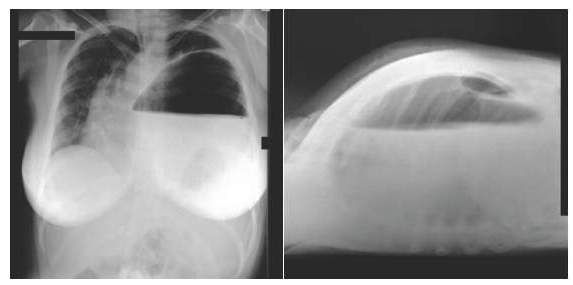Servicios Personalizados
Revista
Articulo
Indicadores
-
 Citado por SciELO
Citado por SciELO
Links relacionados
-
 Similares en
SciELO
Similares en
SciELO
Compartir
Revista Medica Herediana
versión impresa ISSN 1018-130Xversión On-line ISSN 1729-214X
Rev Med Hered vol.30 no.4 Lima oct./dic 2019
http://dx.doi.org/10.20453/rmh.v30i4.3664
IMÁGENES EN MEDICINA
Hernia diafragmática congénita
Congenital diaphragmatic hernia
Jorge Isaac Ramírez Rivera 1,2,a, Zoila Verónica Palacios Sagbay 1,3,b
1 Servicio de Cirugía Pediátrica. Hospital del Niño Dr. Francisco de Icaza Bustamante. Guayaquil, Ecuador.
2 Universidad Internacional del Ecuador. Quito, Ecuador.
3 Universidad de Guayaquil. Guayaquil, Ecuador.
a Cirujano Pediatra; b Médico.
Adolescente mujer de 12 años con taquipnea. Sin historial de trauma, pero con antecedente de infección respiratoria frecuente desde los 2 años. A la auscultación se encontró el latido cardiaco desplazado hacia la derecha y ruidos hidroaéreos en el hemitórax izquierdo. Las radiografías antero posterior y lateral mostraron una imagen aérea ovoide con nivel líquido (figura 1). En la laparotomía transversal izquierda se encontró defecto diafragmático posterior izquierdo o hernia de Bochdalek. Se logró reducir el estómago y colon transverso. El diafragma fue suturado y se colocó un tubo de tórax por 72 h. La paciente egresó al día 7, con evolución favorable. La hernia diafragmática congénita de presentación tardía es infrecuente y muestra un cuadro con síntomas respiratorios o digestivos. El diagnóstico requiere alto nivel de sospecha clínica y es apoyado por medios de imagen, en este caso la radiografía de tórax.

A 12-year old female patient was admitted for tachypnea, there was no history of trauma but she remembered to have had frequent respiratory infections since she was 2 years old. Auscultation revealed displaced heartbeat to the right and abnormal respiratory sounds on the left hemithorax. Chest x-rays revealed an ovoid image with air and fluid content (figure 1). A laparotomy revealed a left posterior diaphragmatic defect also called Bochdaleks hernia. The hernia was surgically repaired and a chest tube was inserted for 72 hours. The patient was discharged on day 7 uneventfully. Late onset diaphragmatic hernia is rare and usually presents with either respiratory or intestinal symptoms. A high index of suspicion is required supported by proper imaging.
Correspondencia:
Jorge Isaac Ramírez Rivera
Correo electrónico: isaacramirezrivera@gmail.com













